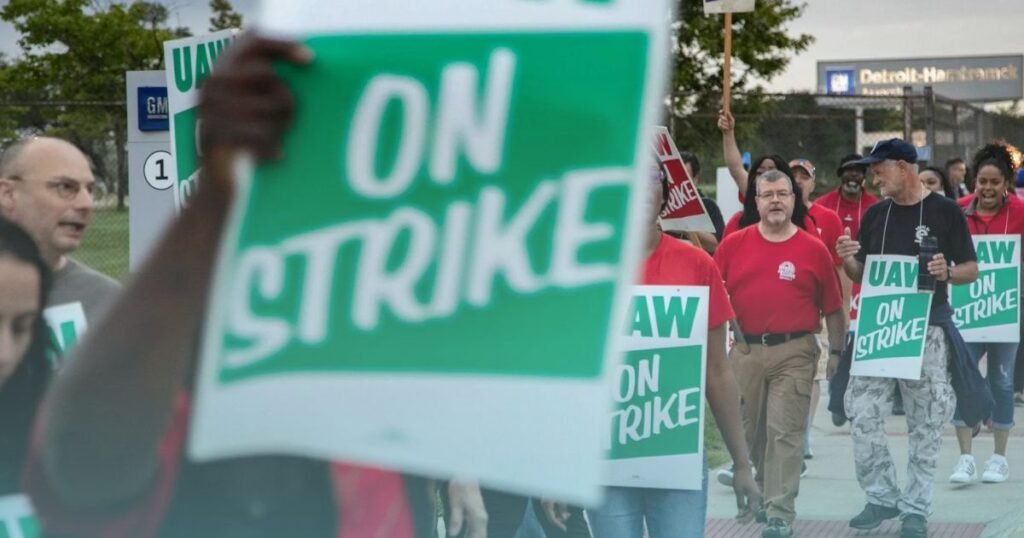UAW: Pat Green feels anxious. He has been working with the Cascades Die Casting Group for the past two years to hire qualified personnel to staff two operations in Grand Rapids that make aluminum and zinc die castings for the machinery and automotive industries.
The company’s CEO, Green, told the Detroit Free Press on Monday, “We now have a great team, and I don’t want to lose people because finding good people was challenging.”
Due to this, tension was rising on the fourth day of the historic United Auto Workers strike against major automakers. In the event that the strike became more severe and lasted for several weeks, Green had carefully planned its strategy in the hopes that it could find a way to lay off employees without really firing them. They had a well-considered strategy.
UAW President Shawn Fain made the final date for the upcoming strike known on Sunday evening. Finn warned that he would extend the walkout to further plants if Ford Motor Company, General Motors, or Stellantis didn’t reach an agreement with the UAW before then.
It is obvious that the United Auto Workers were committed to exerting as much of their bargaining power as they could in talks with these significant automakers. If this occurs, according to Green, he will first stop the company’s use of overtime, after which he will ask staff members to work on a temporary, low-paying project. He started thinking about this at the conclusion of the previous week.
On Thursday at 11:59 p.m., the UAW strike got underway. About 13,000 UAW employees from the three automakers in Detroit left three plants on Thursday as part of the first wave of the ongoing strike until a new labor agreement was achieved. These facilities include the Stellantis Toledo Assembly Complex in Ohio, the GM Wentzville Assembly in Missouri, and the Ford Michigan Assembly Plant in Wayne (which only performs final assembly and painting).
The UAW has at some time expressed its desire to construct additional plants in all three firms if proactive discussions and unions are unable to secure any temporary agreements. The assembly plants making the parts for these cars would be unable to continue production if there were a big and protracted strike. How long suppliers can delay supplies is unknown.
Green stated, “For the most part, we’re in a better state, but if the supply chain issues in China continue, we could face another chip crisis, much like the one before,” in reference to the current semiconductor chip shortage.

The supply chain in China will experience genuine issues if this continues for another five or six weeks, though he continued, “I could be wrong; it could be smaller than that.”
The Fallout Of UAW Strike
According to rumors, the Biden administration is getting ready to provide car suppliers with immediate financial aid in an effort to lessen the long-term effects of the strike. The strike, nevertheless, has already had some noticeable direct impacts. Component manufacturer CIE Newcor has issued a warning that it might be forced to fire 293 workers in Michigan.
According to Tony Sapienza, the director of communications for ZF North America Incorporated, the strike has already forced ZF, a German supplier, to fire certain workers at several locations, including one in Michigan. ZF provides parts for every car created at the three factories hit by the strike, including the Toledo plant’s production of the Jeep Wrangler 4xe hybrid transmission.
Sapienza has refused to say which ZF sites were impacted or how many employees ZF fired. ZF, which has its Northville, Michigan, headquarters, employs 11,000 workers at five manufacturing facilities and four technological hubs.
According to Sapienza, “the impact was immediate; we had to scale back production in some areas.” “A strike becomes a catastrophe for the supply chain if it lasts longer than one or two weeks or gets any wider. Concerning Tier 2 and Tier 3’s ability to maintain solvency, I have serious concerns. The corporation would eventually “necessitate” itself, according to Sapienza, but its scale would help it weather the storm.
Also Read: A House GOP CR Deal To Prevent a Shutdown is in Danger Due To The Rebel Insurrection


Leave a Reply